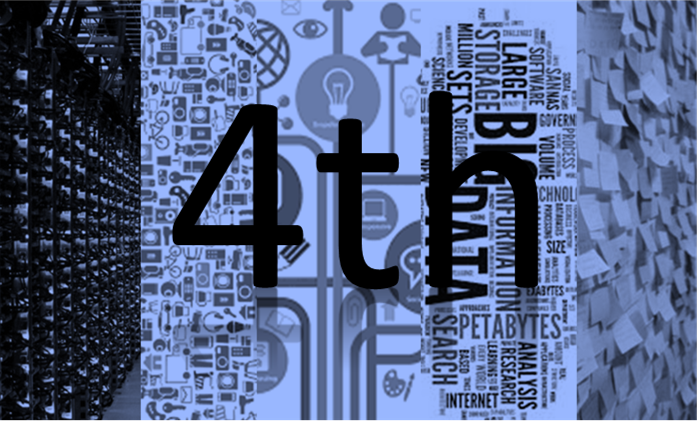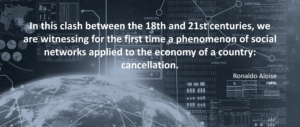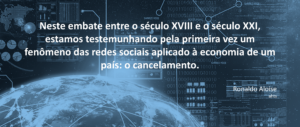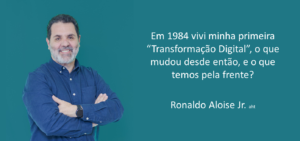“The planet is at an inflection point” – This phrase has arisen spontaneously in many business design meetings we have had. Everyone realizes that big changes are coming around, traditional business models no longer sustain growth, new contexts and technologies challenge us to discover new ways to create value for companies and replace worn models. There is a concern about our readiness to adapt to the future ahead.
In fact, this future has already arrived a few years ago, even in sectors not so related to the Internet, but strongly benefited by technologies such as geo-referencing and the Internet of Things, like energy and agriculture. For example, the use of drones associated with visual computing and sensing is fully incorporated in both planting management and in the supervision of high voltage power lines. Drones dramatically reduce the cost of supervising open-field structures, visual computing helps to diagnose problems and solve them immediately, and sensing (along with predictive algorithms) helps to anticipate maintenance tasks on distribution lines and to correct plantations with “surgical” precision.
The supply of energy has increased due to the integration of traditional sources with alternative energy via smart grids. Agricultural productivity continues to grow thanks to new technologies for real-time maintenance of crops with punctual and sustainable operations, reducing the use of chemicals and even producing up to 10 times more than 30 years ago in the same-planted area in some cases. The problem will not be scarcity, if we look at the historical growth of wealth generation on the planet in the last 100 years it is clear that we are on a ramp of continuous growth since the first industrial revolution.
However, if wealth growth is not an uncertainty, employment growth is. As technology takes up ever more space, business models and employability are at the focus of big concerns. The fourth industrial revolution will generate more wealth, and at exponential rates, but much of this caused rather by technological disruptions, that create much cheaper products usually based on software and electronics. Just as products “disappear” (seen mobile software), sales channels disappear as well, the internet has enabled business relationships with fewer intermediaries. Fewer intermediaries imply less hierarchy, and this is a characteristic of current times, ERP software for example, are structures as hierarchical as the management structures that demanded them; new companies do not appear like this. New companies are agile, change direction more easily, fail and correct more quickly. Too much hierarchy constrains agility.
Summarizing, disruptions, disarrangements, and disintermediation are the phenomena that really challenge current production and commercial models. Analyzing that impact on business models is a necessary path. Today, to fuel a business design process, we need to assess impacts in these three areas: Disruptive Technologies, Go-To-Market Models, and Sustainable Financial Models. These three areas of influence intertwine and often act together. We need to ask ourselves how we will act and continue to grow in this new context.
Some of the technologies that already cause disruptions and wealth growth: Geo-referencing, Machine Learning, IoT and Sensing, Nanotechnology, Drones and Robots, Big Data, Algorithmization, Genetic Editing, Fintechs. How can they strengthen our company? What opportunities do they bring us? Can they pose any threat as a competitor with such a disruptive offer that could kill my business?
We must take the same approach for the Go-To-Market area. The disintermediation of relationships promoted by the Internet, coupled with Big Data’s behavioral data analysis algorithms, allow marketing to be individual, behavioral, and digital. Distribution-centered logistics models have already been replaced by hybrid distributed distribution models (Omni Channels), where physical stores, distribution centers and multimodal transport work together to deliver quickly, without having to keep high stocks for prompt delivery. Although to date, in most companies that have a differential in delivery, the solution adopted for agility is the high stock; such policy is no longer affordable. Behavioral algorithms trigger the “mental alarm” of the desire to buy, direct the customer to purchase, and execute the delivery process in a matter of seconds or minutes on each individual’s smartphone. How to deal with all this in a way that builds a new economic paradigm, more sustainable and equitable for humanity?
In the financial area, the challenges are modeling the financial mindset, not just the processes and tools. New businesses seek to use much more leveraged or outsourced assets than investing heavily in fixed assets, giving more emphasis to the ROCE (Return on Capital Employed) concept that measures and manages more effectively both the multidimensionality of capital (Financial, technological, intellectual, human, energetic-environmental, social) as well as the multidimensionality of gains created (same diversities of capital employed). The marginal cost practically comes out of many financial equations, especially those of digital products, where it tends to zero (software and digital services for example), because they practically do not have extra cost when the production increases. The labor forces become more flexible, the financing has less fixed assets to demand as collateral, and the excellence of the transactional dynamics starts to play a leading role.
Therefore, in this phase of “inflection point of the planet”, it is not enough “just” to make strategic planning, which is usually a tool that projects the future based on the premises and results of the past. As we face an inflection point coming around the corner, it does not make much sense drawing the future based on the past.
What comes ahead is new to most companies, so it is necessary to explore the many tools available for business design, we need to analyze in depth all the impacts mentioned above and, based on this, design the future of company under the light of these new concepts.
We must ideate, experiment, prototype, validate, undertake the new business model design in a controlled environment. Moreover, without compromising the current structure, on the contrary, taking advantage of it, because it will benefit from the changes later. For now, the current business model is the sponsor and the funding provider of the new design, it is wise insofar as it has come this far successfully, it understands management.
So we need to take advantage of what “years of management” have given us of knowledge, but also explore the new, break paradigms and achieve not only new levels of management and growth, but mainly a new key “mindset”, which is to establish a balance between administration and design, resulting in a continuous learning process. This condition is fundamental to reach sustainable growth from now on.
We hope you have enjoyed this article; it represents a bit of our thinking about how to approach business design. You can find more at our site www.waytogrow.com.br.
Thank you!
“The planet is at an inflection point” – This phrase has arisen spontaneously in many business design meetings we have had. Everyone realizes that big changes are coming around, traditional business models no longer sustain growth, new contexts and technologies challenge us to discover new ways to create value for companies and replace worn models. There is a concern about our readiness to adapt to the future ahead.
In fact, this future has already arrived a few years ago, even in sectors not so related to the Internet, but strongly benefited by technologies such as geo-referencing and the Internet of Things, like energy and agriculture. For example, the use of drones associated with visual computing and sensing is fully incorporated in both planting management and in the supervision of high voltage power lines. Drones dramatically reduce the cost of supervising open-field structures, visual computing helps to diagnose problems and solve them immediately, and sensing (along with predictive algorithms) helps to anticipate maintenance tasks on distribution lines and to correct plantations with “surgical” precision.
The supply of energy has increased due to the integration of traditional sources with alternative energy via smart grids. Agricultural productivity continues to grow thanks to new technologies for real-time maintenance of crops with punctual and sustainable operations, reducing the use of chemicals and even producing up to 10 times more than 30 years ago in the same-planted area in some cases. The problem will not be scarcity, if we look at the historical growth of wealth generation on the planet in the last 100 years it is clear that we are on a ramp of continuous growth since the first industrial revolution.
However, if wealth growth is not an uncertainty, employment growth is. As technology takes up ever more space, business models and employability are at the focus of big concerns. The fourth industrial revolution will generate more wealth, and at exponential rates, but much of this caused rather by technological disruptions, that create much cheaper products usually based on software and electronics. Just as products “disappear” (seen mobile software), sales channels disappear as well, the internet has enabled business relationships with fewer intermediaries. Fewer intermediaries imply less hierarchy, and this is a characteristic of current times, ERP software for example, are structures as hierarchical as the management structures that demanded them; new companies do not appear like this. New companies are agile, change direction more easily, fail and correct more quickly. Too much hierarchy constrains agility.
Summarizing, disruptions, disarrangements, and disintermediation are the phenomena that really challenge current production and commercial models. Analyzing that impact on business models is a necessary path. Today, to fuel a business design process, we need to assess impacts in these three areas: Disruptive Technologies, Go-To-Market Models, and Sustainable Financial Models. These three areas of influence intertwine and often act together. We need to ask ourselves how we will act and continue to grow in this new context.
Some of the technologies that already cause disruptions and wealth growth: Geo-referencing, Machine Learning, IoT and Sensing, Nanotechnology, Drones and Robots, Big Data, Algorithmization, Genetic Editing, Fintechs. How can they strengthen our company? What opportunities do they bring us? Can they pose any threat as a competitor with such a disruptive offer that could kill my business?
We must take the same approach for the Go-To-Market area. The disintermediation of relationships promoted by the Internet, coupled with Big Data’s behavioral data analysis algorithms, allow marketing to be individual, behavioral, and digital. Distribution-centered logistics models have already been replaced by hybrid distributed distribution models (Omni Channels), where physical stores, distribution centers and multimodal transport work together to deliver quickly, without having to keep high stocks for prompt delivery. Although to date, in most companies that have a differential in delivery, the solution adopted for agility is the high stock; such policy is no longer affordable. Behavioral algorithms trigger the “mental alarm” of the desire to buy, direct the customer to purchase, and execute the delivery process in a matter of seconds or minutes on each individual’s smartphone. How to deal with all this in a way that builds a new economic paradigm, more sustainable and equitable for humanity?
In the financial area, the challenges are modeling the financial mindset, not just the processes and tools. New businesses seek to use much more leveraged or outsourced assets than investing heavily in fixed assets, giving more emphasis to the ROCE (Return on Capital Employed) concept that measures and manages more effectively both the multidimensionality of capital (Financial, technological, intellectual, human, energetic-environmental, social) as well as the multidimensionality of gains created (same diversities of capital employed). The marginal cost practically comes out of many financial equations, especially those of digital products, where it tends to zero (software and digital services for example), because they practically do not have extra cost when the production increases. The labor forces become more flexible, the financing has less fixed assets to demand as collateral, and the excellence of the transactional dynamics starts to play a leading role.
Therefore, in this phase of “inflection point of the planet”, it is not enough “just” to make strategic planning, which is usually a tool that projects the future based on the premises and results of the past. As we face an inflection point coming around the corner, it does not make much sense drawing the future based on the past.
What comes ahead is new to most companies, so it is necessary to explore the many tools available for business design, we need to analyze in depth all the impacts mentioned above and, based on this, design the future of company under the light of these new concepts.
We must ideate, experiment, prototype, validate, undertake the new business model design in a controlled environment. Moreover, without compromising the current structure, on the contrary, taking advantage of it, because it will benefit from the changes later. For now, the current business model is the sponsor and the funding provider of the new design, it is wise insofar as it has come this far successfully, it understands management.
So we need to take advantage of what “years of management” have given us of knowledge, but also explore the new, break paradigms and achieve not only new levels of management and growth, but mainly a new key “mindset”, which is to establish a balance between administration and design, resulting in a continuous learning process. This condition is fundamental to reach sustainable growth from now on.
We hope you have enjoyed this article; it represents a bit of our thinking about how to approach business design. You can find more at our site www.waytogrow.com.br.
Thank you!






